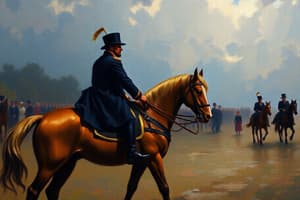Podcast
Questions and Answers
What was one of the main issues with the Tsar's management of government officials?
What was one of the main issues with the Tsar's management of government officials?
- He often made swift decisions to resolve issues.
- He encouraged rivalry among government departments. (correct)
- He promoted collaboration between departments.
- He relied predominantly on competent family members.
Which group primarily made up the Socialist Revolutionaries?
Which group primarily made up the Socialist Revolutionaries?
- Workers in the cities.
- Minor landlords.
- Middle class liberals.
- Radical peasants. (correct)
What event is referred to as Bloody Sunday in 1905?
What event is referred to as Bloody Sunday in 1905?
- A peaceful demonstration that ended with victims shot by soldiers. (correct)
- A failed military uprising in St. Petersburg.
- The signing of a peace treaty with Japan.
- A mass protest against government censorship.
How did the Tsar attempt to control the peasant population?
How did the Tsar attempt to control the peasant population?
Which division of the Social Democratic Party was in favor of immediate revolution?
Which division of the Social Democratic Party was in favor of immediate revolution?
What major event led to a loss of respect for the Tsar among peasants?
What major event led to a loss of respect for the Tsar among peasants?
Why did the Tsar's ministers warn him of a potential revolution?
Why did the Tsar's ministers warn him of a potential revolution?
What significant action did peasants take during the 1905 revolution?
What significant action did peasants take during the 1905 revolution?
What proportion of Russia’s population were peasants during the rule of Tsar Nicholas?
What proportion of Russia’s population were peasants during the rule of Tsar Nicholas?
What was the main concern of the peasants during Tsar Nicholas's rule?
What was the main concern of the peasants during Tsar Nicholas's rule?
Which group had the greatest fear of losing their land to peasants?
Which group had the greatest fear of losing their land to peasants?
What was a significant outcome of the policies introduced by Sergei Witte in the late 1900s?
What was a significant outcome of the policies introduced by Sergei Witte in the late 1900s?
What was the primary way the land was organized among peasants?
What was the primary way the land was organized among peasants?
Which statement accurately describes the living conditions of workers in urban areas during Tsar Nicholas's rule?
Which statement accurately describes the living conditions of workers in urban areas during Tsar Nicholas's rule?
Which class emerged as a result of industrialization during this period?
Which class emerged as a result of industrialization during this period?
What type of government did Tsar Nicholas lead?
What type of government did Tsar Nicholas lead?
Flashcards are hidden until you start studying
Study Notes
The Tsar’s Empire
- Vast empire with diverse nationalities; loyalty varied among populations.
- The Tsar held supreme authority, a complex and challenging role.
- Jews faced severe persecution through government-sponsored pogroms.
Peasants and the Countryside
- Approximately 80% of Russia's population comprised peasants, primarily living in communes.
- Kulaks represented a prosperous group of peasant farmers, but most lived in dire conditions.
- Famine and starvation were prevalent due to low life expectancy and poor agricultural practices.
- Population increased by 50% by the early 1900s, exacerbating land shortages.
- Traditional farming methods persisted; land was divided into strips managed by peasant councils (mir).
- Tsar perceived as a divine authority; loyalty expected from peasants despite many aligning with opposing forces like the Social Revolutionaries.
- Land ownership issues fueled anger; peasants resented the aristocracy and the Church's control.
Aristocracy
- Represented about 1.5% of the population yet owned 25% of all land.
- Enjoyed lavish lifestyles and played a crucial role in government support for the Tsar.
- Feared peasant uprisings leading to land confiscation.
Workers and Urbanization
- Late 1900s marked a push toward industrialization, with policies introduced by Sergei Witte stimulating growth in oil, coal, and iron production.
- Urban migration led many peasants to seek work in factories, resulting in overcrowded, impoverished living conditions in cities.
- Poor living standards were common, alongside widespread issues of disease and alcoholism.
Middle Class
- Industrialization resulted in the emergence of a capitalist middle class, including landowners, bankers, traders, and businessmen.
- Although a small percentage of the populace, this class grew primarily in urban areas and significantly managed the economy.
- Tensions arose between capitalists and workers, foreshadowing future conflicts in Russian history.
The Tsar and His Government
- Autocratic rule provided the Tsar with absolute power, propped up by the Church.
- Governance marked by poor decision-making and rivalry among officials, leading to inefficiency.
- Many governmental positions occupied by family members, contributing to incompetence and corruption.
Control and Resistance
- Peasant control exercised through the mir, with local governance often undermined by land captains appointed by the Tsar.
- Zemstva (local assemblies) aided Russian governance, while local governors enforced Tsar's directives.
- The regime utilized police-state tactics including arbitrary arrests, censorship, and heavy fines to suppress dissent.
Opposition to the Tsar
- Opposition stemmed from three main groups:
- Middle class seeking democratic reforms (Liberals/Cadets).
- Socialist Revolutionaries advocating for a radical peasant-led revolution.
- Social Democratic Party divided into Bolsheviks (led by Lenin, pushing for immediate revolution) and Mensheviks (arguing Russia was unprepared for revolution).
- By 1903, escalating strikes and protests highlighted growing unrest and dissatisfaction with the Tsar's administration.
The 1905 Revolution
- Government relaxed censorship pre-1905 crisis, leading to a surge of anti-government materials.
- Tsar's military failure in the war against Japan heightened discontent.
- Bloody Sunday, January 22, 1905: 200,000 protesters approached the Winter Palace to petition the Tsar, who was absent.
- Soldiers fired on protesters, damaging the Tsar's reputation and leading to public outrage.
- General strikes and the creation of worker’s councils (Soviets) emerged in response to violent repression.
- Peasants revolted against landlords, spurring further unrest and challenges to Tsarist authority.
Studying That Suits You
Use AI to generate personalized quizzes and flashcards to suit your learning preferences.





